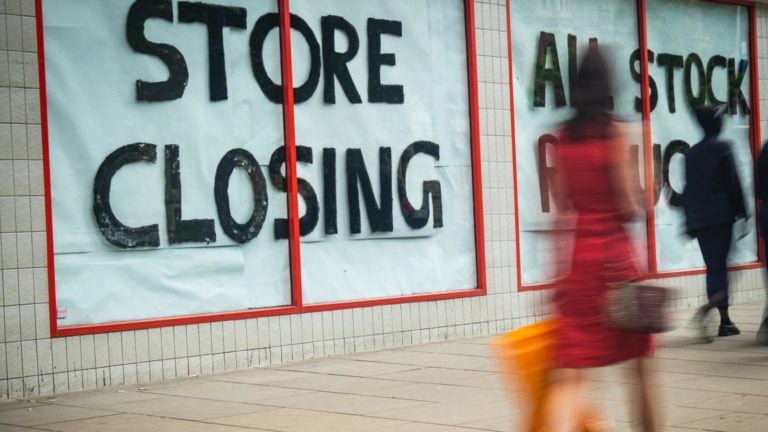The big story in the retail sector is the new look for Walmart (NYSE:WMT) that resulted in better earnings. The result was a soaring share price for the world’s largest retailer. There are many reasons for success like this for Walmart; and it is shown by many measures.
One of the most important indicators for a retailer is the cash conversion cycle. That reveals how quickly goods are sold, how fast merchandise becomes money. For Walmart it is super low at less than four days. The average cash conversion cycle for a department store is around 30 days. Walmart knows its customers! Also low for Walmart is the short float under 1%, which shows that few are betting that the share price will fall. Anything above 10% is considered high. Those wagering that Walmart stock will rise have been rewarded as it is up more than 20% for 2024!
But there are many tales of woe for others among retail stocks to sell. Walmart and Amazon (NASDAQ:AMZN) have crushed much of the competition. Others are struggling from crime and the aftermath of the pandemic. More are working from home, depriving retailers of foot traffic from those at nearby offices. For many, the Peter Lynch approach of visiting and seeing who is busy can be utilized to make an investing decision.
American Eagle Outfitters (AEO)

There will certainly be far fewer American Eagle Outfitters (NYSE:AEO) stores to visit as up to 500 could be closed in the next two years. Earlier this month, it was announced that the store in downtown San Francisco will close on Jun. 12. Merchandise is not moving. The cash conversion cycle is nearly two months when the industry average is 30 days.
When goods are not selling it shows up everywhere on the balance sheet and the income statement of retail stocks to sell. American Eagle is certainly no different. Mass closings of stores will save money but it hardly inspires confidence among investors for the long term as it means that merchandise is not selling enough to keep those locations open.
The numbers certainly tell that story. For the first quarter of 2024, the average profit margin for the S&P 500 was 11.7%. For American Eagle Outfitters, it is 3.23%. Returns on assets and income are in single digits, too. The short float is in double digits, meaning many are betting the share price will fall. Shutting down hundreds of stores will not change that bearish outlook to bullish. Moreover, earnings are down by double digits over the last five years. Like the short float, debt is very high, too.
While the stock has had a good run, it was down for the last week of market action. Selling into strength and running away with a profit is never a bad idea. The crushing debt, the unhealthy cash conversion cycle, anemic margins, the big short and the closing of 5oo stores highlight the weaknesses of American Eagle Outfitters.
Big Lots (BIG)

Big Lots (NYSE:BIG) is a discount retailer headquartered in Columbus, Ohio that expanded to well over 1000 stores across the United States. This expansion was costly and did not go well due to competition and the pandemic. As a result, the short ratio and debt ratio are staggeringly high. The share price has fallen so much it is a classic value trap as the price to sales, price to book, and price to cash ratios are alluring to the unsuspecting in retail stocks to sell as each is in low single digits.
But the share price has fallen more than 50% this year for lots of reasons. Its cash conversion cycle is 82 days, almost three months. American Eagle Outfitters is looking to shut down 500 stores with a cash conversion ratio of less than two months as a comparison.
Channeling my inner Peter Lynch, there was a Big Lots store near a place I used to own in New Hampshire. The store and parking lot never seemed to have any customers. Nearby there was a Walmart that was always bustling. Moreover, the retail king had many vehicles with license plates from Canada, Maine and Vermont. That was never the case with the Big Lots’ store…go figure!
Foot Locker (FL)

Look at it this way: When Nike (NYSE:NKE) sneezes, Foot Locker (NYSE:FL) catches the flu as about 55% of the sales of the retailer carry The Swoosh!
Nike is hobbled with sales flat and earnings down on a quarterly basis, so Foot Locker is limping. Foot Locker is moving away from its dependency on Nike, which was around 70% earlier in the decade. But Foot Locker is having to rebuild as a result. And that means shutting down stores, planning to close 400 by 2026.
Nike goes after a younger demographic with the “typical customer” being a GenX male. The average age in America is close to 40, in 1960 it was under 30. The country is getting older! It is never a good idea for a retailer to be on the wrong side of societal trends as “demographics are destiny.” Foot Locker stock is down nearly 50% over the last year. Sales and earnings are off, and, unsurprisingly, it is losing money. The stores of Foot Locker may not be attracting customers but the stock sure has shorts circling with a high percentage betting the share price will fall.
Disclosure:On the date of publication, Jonathan Yates did not have (either directly or indirectly) any positions in the securities mentioned in this article. The opinions expressed in this article are those of the writer, subject to the InvestorPlace.com Publishing Guidelines.
